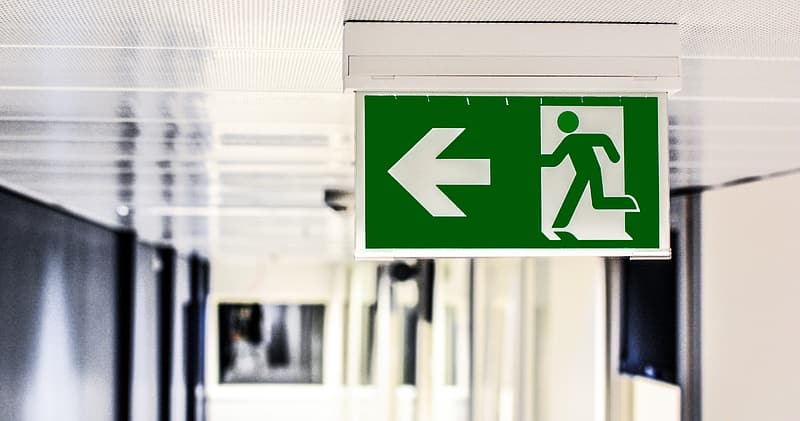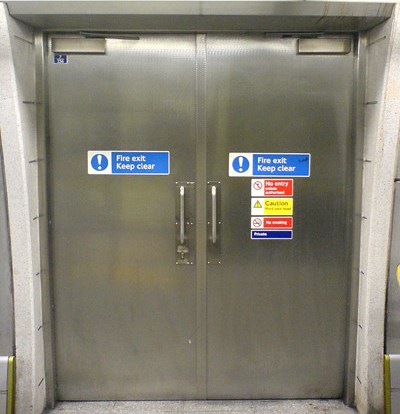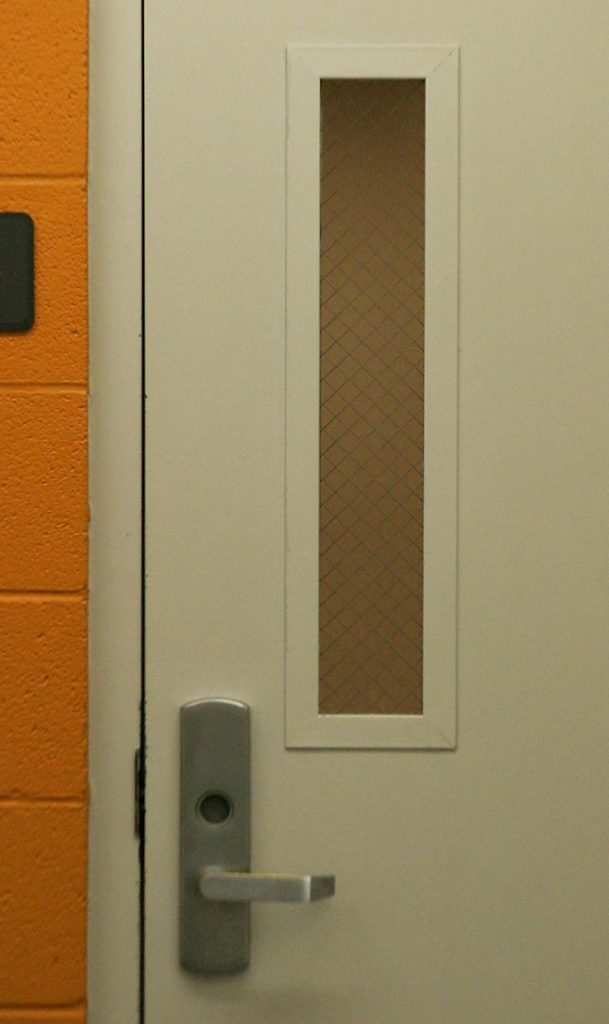What could be easier than a door? Historians and archaeologists do not undertake to say with certainty when a person first began to defend his home with their help.
And today their purpose is still the same - to restrict access to the premises, but the design and materials have seriously changed. In the age of advanced technologies and specialization, many of their varieties have appeared, designed for certain conditions of functioning and operation.
Content
Fire door
All door structures can be simplified into two main classes:
- External. They are placed in order to separate the premises from the street.
- Internal. Installed to separate rooms and restrict access to them.
Regardless of the materials of which they are made, the purpose of any door is to preserve the microclimate in the room and restrict access to it.
But there is one thing that is more unpleasant than the visit of annoying visitors or even thieves - this is a fire. And often it is the doors that become the weak link in fire protection. Stone walls or wood with a fire retardant impregnation will withstand the onslaught of the flame, while the door leaf may not withstand, catch fire, deform under the influence of high temperatures and make it impossible to exit the building. A loose fit of the canvas, cracks, the absence of a threshold can lead to the penetration of combustion products: smoke and carbon monoxide inside, and they pose an immediate threat to life and health.

Where is it necessary to install a fire door?
Places where the installation of this kind of products is required are clearly regulated. The door structure is part of the fire barrier, forming a single whole with it. The purpose of the barrier is to prevent the spread of flame and combustion products from room to room, between buildings or from the street.
If, according to the construction documentation, a wall or structure is a fire barrier, installation is mandatory.

Thus, the places of mandatory use of fire-resistant entrance structures are:
- Evacuation and fire exits from buildings and structures in places of mass stay of people. (Educational, medical institutions, trade and exhibition complexes, railway stations, airports, entertainment establishments).
- Technical premises (switchboard, server rooms, ventilation chambers).
- Places of storage and storage of flammable substances.
- Exits from the stairs to the attic
- Through corridors and elevator shafts.
In technical documentation and from manufacturers, fire doors are designated by the abbreviation "PD". In regulatory documents, it is customary to designate other fire-resistant structures with the same abbreviation - hatches, gates, windows, curtains, curtains. In this review, we will not dwell on the aforementioned structures, therefore, the abbreviation "PD" will mean doors.
Only a structure that has a certificate of conformity in the established sample and has passed tests confirming its protective properties can be considered fireproof.
The manufacturer's assurances alone in such a serious matter as reliability and flame resistance are not enough, therefore everyone who plans to sell their products as fire-resistant must pass the appropriate tests without fail.
For testing, a sample of products is provided to the laboratory, which is installed in a special room. In this case, the completeness and installation technology must be strictly observed.
After installation, thermocouples are fixed to the door in accordance with the standards, fixing the temperature on the surface. Next, a furnace or gas burners comes into play, simulating a fire.
Experts measure the time from the beginning of the test, until the first signs of the limiting states of the sample appear. The product receives a corresponding certificate based on the test report.
Main characteristics of PD
Fire resistance limit
This indicator denotes the period of time in minutes from the moment when the flame began to interact with the surface to the onset of one or more limit states.
There are three main limiting states:
Loss of integrity (E)
The appearance of holes or through cracks on the sample, or the appearance of a flame on the opposite side of the surface for a period of more than 10 seconds.
After testing, the product is assigned the appropriate index, for example, E 60.
This means that the entrance structure will be able to withstand the onslaught of fire for at least 60 minutes, while not letting it inside the room.
Loss of thermal insulation (I)
Heating the back side of the sample surface to a temperature above 140 ° C, or reaching a temperature of 220 ° C on the door frame.
This indicator is also included in the index, which is measured in minutes. Often the indices are added, while taking as a basis the indicator that is shorter in time.
For clarity, a sample of class EI 60 should not lose its heat-insulating properties under the influence of fire within an hour, while the time until the integrity is broken may take longer, but the first indicator will be taken into account.
Resistance to penetration of gases and cold fumes (S)
It characterizes the tightness of the structure and the ability to restrain the penetration of combustion products into the room. Often they are the ones that pose the greatest danger to life and health. This characteristic is also added to the door brand.
Loss of bearing capacity (K)
Deformation of the canvas or box, preventing it from opening, Falling out of the canvas from the box or the box itself from the doorway.
The most common coefficients of resistance to ultimate loads are 30, 60 and 90 minutes. It is believed that this time is sufficient to localize the fire or evacuate people. There are models with an index of 120, but they are more exotic. In addition, in two hours of fire, the fire often destroys the walls themselves, and deforms the supporting structures so that the door no longer creates any serious protection for the fire element.
Thus, the E 180 is more of a marketing ploy and the slyness of the manufacturer, moreover, in matters in which this, to put it mildly, is unacceptable.
What are fire doors
- Width:
Bivalves, One and a half, Single.
- By fabric and box material
Metal: Made of steel with a thickness of at least 1 mm. The interior is filled with high density mineral wool. A seal must be installed around the perimeter of the Box to ensure tightness.
Wooden: They are made of wood impregnated with mixtures that prevent combustion. The outer surface is decorated with MDF. The fire resistance of such structures is low, but they have one indisputable advantage - lightness. It is also easier to crack if needed.
Aluminum: Due to the high thermal conductivity of aluminum, they have a low resistance to deformation and fire resistance, therefore they are reinforced with a steel profile. Most often they are made in combination with glass.
- By design
Deaf: Solid canvas.
Glazed: If you need visual control of what is happening, a canvas with special tempered glass is suitable. As a rule, a double-glazed window is multilayer, the space between the glass sheets is filled with a special non-combustible gel.
On sale, you can periodically find plastic PDs. However, any plastic, when heated, either emits toxic substances or deforms quickly, because fire-resistant plastic or PVC products do not exist.
Accessories and fittings for fireproof entrance structures
Like any other, fire-rated doors need fittings. It includes:
- Hinges, handles (including "anti-panic", which make it easy to open the sash in an extreme situation), closers that ensure reliable closing of the sashes.
- Seals. A cord installed around the perimeter of the sash or doorway. Seals the door when closed. It needs periodic replacement, as it loses its elastic properties over time.
There is a special cords that, when heated, foam and increase in volume, reliably blocking the access to the room of combustion products and smoke. And air, which, although good for extinguishing a fire, is not at all fun if you find yourself locked behind such a door.
- A number of models are equipped with ventilation grilles.
Like the doors themselves, all fittings must be designed to withstand high temperatures.
Disadvantages of fire doors
These include low resistance to burglary. The complex mechanisms of locks when heated can fail and make evacuation impossible. For the same reason, 4-sided locking mechanisms are not installed in fire-resistant products. The rods of the locks are deformed with strong heating, and the crossbars with a high degree of probability will jam the canvas in the opening, jeopardizing the possibility of leaving the house.
The best solution would be a combination of a conventional high-security door and a fire-resistant model, which is installed in the vestibule or hall.
Installation of fire doors
When buying, ask the seller if he can install a door for you. The fact is that for the installation of such products, the company must necessarily have a certificate. Of course, for home use, this may not be critical, but it is extremely important when installed in an institution or enterprise.
If the seller cannot provide this service, you will have to spend time looking for the appropriate office, so you will avoid problems during the delivery of the object and fire checks.
The best fire door manufacturers for 2020
AKS GROUP
In seventh place in the rating is the Russian company AKS GROUP, which specializes in the production of aluminum fire doors.
In the manufacture, the developments of Italian manufacturers are used, in particular, the fire-prevention profile systems from NewTec. The company's catalog contains translucent aluminum structures of the EIWS 30 and EIWS 60 classes. For glazing, special fireproof glass units are used.
The use of fire-resistant glass and a thermally expanding film differs from the usual such double-glazed unit. Placed between sheets of glass, when heated, it expands, filling the internal space, and prevents the destruction of the package and the penetration of combustion products into the room.
In addition to laminated glass, a popular solution is filling the cavities of glass units with a special fire-fighting gel. With prolonged heating, the tempered glass breaks down, the gel behind it crystallizes and forms a refractory mass, which prevents heating of the surfaces located behind it.
The model range of AKS GROUP includes single-field and double-field PD models.
In addition to the doors, the company designs entrances with flame-resistant glazing and light-permeable partitions of the EIW 30 and EIW 60 class.
The main areas of application of the products are shopping and office centers, airports, train stations, entrance groups of apartment buildings and hotels.
At the request of the customer, the manufacturer can paint the finished product in any of the RAL colors.
AKS GROUP has a valid certificate for the installation of PD issued by the Ministry of Emergency Situations, which means that you do not have to waste time looking for installers. And all the work will be done quickly and will be performed with high quality.
Advantages:
- Attractive appearance;
- Large selection of fittings.
Disadvantages:
- High cost of finished products;
- Long production time. (Delays are possible due to the long delivery of foreign components).
VERDA
The sixth place of the review is with the PD manufacturer from the Moscow region.
It specializes in the production of fire-resistant door structures. The company produces metal fire doors that meet the EI 30 and EI 60 classes.
The filler is high-density basalt wool, which can withstand temperatures up to 1000 ° C.
At the request of the customer, structures with translucent inserts up to 25% of the glazing of the total area of the product can be made.
All products must be tested by fire and have all the necessary certificates for use as PD.
The outer surface is painted with powder paint, which does not emit toxic substances when heated. The standard color range is gray or red, however, if the customer wishes, the product can be painted in a different color.
Advantages:
- Reliable locking mechanisms;
- Resistant powder coating.
Disadvantages:
- Not identified.
Titanium
In fifth place is the supplier of metal PD Titan. The head office and main production are located in Tver. The company has been on the market since 1998. Like most manufacturers, the company initially dealt with metal doors. At the time of its foundation, fire-resistant doors were more exotic, were expensive and were not in great demand among buyers.
However, the market dictates its own rules, and over time, a line for the production of PD was launched on Titan.
The company manufactures standard metal structures made of metal filled with high-strength non-combustible mineral filler. The fire resistance limit is from 30 to 60 minutes.
The range includes single and double-leaf models, fixed and with laminated glass glazing for visibility and control.
All materials and accessories meet the requirements of GOST.
Advantages:
- Resistant, durable powder coating;
- Reliable locking mechanisms.
Disadvantages:
- Not identified.
Thermostop NPP
Manufacturer from the Republic of Tatarstan. The company specializes in the production of fire-resistant products, and presents a wide range of products: from doors to gates. Protection classes of manufactured products: EI60 and EI90. Recently, fresh developments have been launched into production with a fire resistance limit of at least 120 minutes, which is the maximum indicator for this type of product.
A similar value is achieved due to the reinforced profile, a thicker layer of mineral filler and a double-circuit seal around the perimeter. The weight of such a PD is higher than a typical product, therefore, for reliability, the sash is equipped with three hinges.
The industry standard is to use flame retardant polymer powder paint.
Doors from Thermostop NPP meet the requirements of GOSTs and standards and are widely used in the republic and beyond.
Advantages:
- High fire resistance;
- Good build quality.
Disadvantages:
- A small selection of glazed models.
DM-Service
The third line of the rating belongs to the Belarusian company, in the model line of which there are metal doors and canvases with translucent inserts. The range includes single-field and double-field PDs.The fire resistance limit, depending on the model, varies from 30 to 90 minutes.
Construction and materials are standard for this class of products: These are fire-resistant hinges and heat-resistant non-flammable handles that can withstand open flames without significant heating.
At the request of the buyer, the complete set can be additionally included door closers or anti-panic handles.
All samples presented for sale are certified for sale in the Russian Federation.
Advantages:
- Large selection of fittings;
- Affordable prices;
Disadvantages:
- Not identified.
Torex
The company from Saratov ranks second in the ranking. Buyers know the brand well as a manufacturer of reliable entrance doors, however, they are not the only ones in the company's assortment. Keeping pace with the times, PD production was launched at the plant.
In production, we use our own profiles, reinforced to prevent deformation. Basalt wool, which has already become familiar, is used as a filler.
A distinctive feature of Torex products is excellent sound insulation and tightness.
When assembling the finished product, a seal is used to prevent the ingress of smoke and combustion products into the protected room. The fire resistance values of the manufactured PD are from 30 to 60 minutes, depending on the materials used.
Advantages:
- High performance of sound insulation and tightness.
Disadvantages:
- There were complaints about the operation of locks in single-door doors.
Argus
In the first place is a time-tested manufacturer from the city of Yoshkar-Ola. The company was founded in 2001 and initially was engaged in the production of steel doors. Over time, production grew, new technologies were mastered. New lines and capacities were put into operation.
The company's models are always popular with buyers due to their democratic prices and reliability.
Today, a separate division of the holding is responsible for the production of fire doors. The assortment includes single metal models with a thickness of 1 mm and 1.2 mm. At the request of the customer, the company's specialists will produce a product of non-standard sizes.
Fire resistance class of manufactured PDs: EI30 and EI60.
A feature of the manufactured models is their own patented design, which enhances the bearing capacity of the door and increases its resistance to deformation.
The complete set uses fittings that are resistant to high temperatures and handles that do not heat up when in contact with a flame.
Fire-resistant basalt-based mineral wool is used as a filler. All manufactured models have certificates and comply with GOST.
Advantages:
- Reliable fittings;
- Low prices.
Disadvantages:
- There are no doors in the line without thresholds and with descending thresholds;
Tips for choosing fire doors
Entrust the calculations of the product class and installation to professionals. The fire barrier must have a fire resistance not lower than the entrance structure.
Do not hesitate to ask the seller for a certificate of conformity.
Don't be tempted to buy cheap. In this case, a low price with a high degree of probability will mean that you will receive a product that will not be able to adequately withstand the fire due to low-quality or cheap materials.
Be sure to install a fire alarm. Remember that no matter what index is in the passport of your door, it will not hold out against the onslaught of flame for more than one and a half to two hours, and even then, if its fire resistance class is from 90 to 120 minutes, which is a rarity. If a signal is given in a timely manner, localizing the fire or carrying out an evacuation can be much faster, which means that losses among people can be avoided and damage to structures and property can be minimized.
If you have experience in operating fire doors, share it in the comments.













